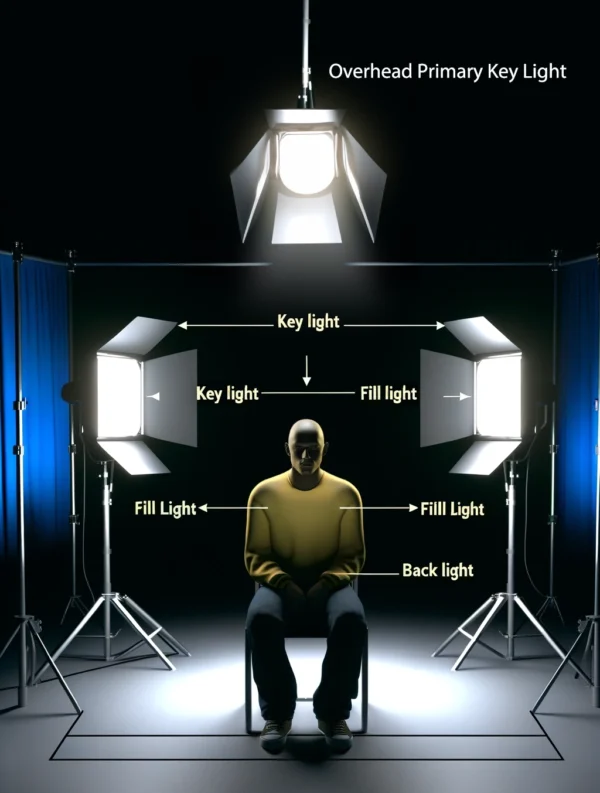
Lighting and Exposure in Digital Cinematography
Lighting plays a pivotal role in digital cinematography, not just in illuminating a scene, but in shaping the visual narrative, setting the mood, and guiding the viewer’s focus. Here are several key lessons on lighting that are essential for aspiring cinematographers:
Cinematography Basics: An in-depth look at the Three-Point Lighting System
A key light in photography is the primary source of light used to illuminate the subject. It’s the most important and usually the brightest light in a lighting setup, setting the overall tone, mood, and direction of the shadows in the image. Positioned strategically, often at a 45-degree angle to the subject, the key light shapes the scene and defines the texture, contrast, and shadows, playing a crucial role in the visual storytelling process.
The choice of key light, its placement, and its intensity directly influence the appearance of the subject and the atmosphere of the photograph.Here’s a concise guide to effectively setting up a key light and utilizing various filmmaking elements to enhance the mood of your photographic direction. The ‘Key Light’ is your main source of light for a given scene, typically positioned at a 45-degree angle to the subject. It establishes the overall look and feel of the subject matter being filmed. This covers animated as well as stationary objects, people, characters, vehicles, products and more.
What is critical to the success of your scene is being able to identify the Mood of the scene as it relates to your subject matter: Begin by determining the atmosphere you aim to create. The key light’s position, intensity, and color significantly influence the scene’s emotional tone. Understanding the narrative’s emotional arc is critical. Deep analysis of the script helps in grasping the intended emotions, allowing you to visualize how lighting, colors, and camera angles can mirror the scene’s mood.
Utilizing Lighting Effects - Capturing Cinematic Mood and Direction
There are additional important factors to consider having to do with lighting techniques: The techniques include how the placement and characteristics of the primary key lights are instrumental in mood alteration. For example, Soft, diffused lighting can imply warmth and safety, whereas harsh, direct lighting may introduce conflict or mystery. The color temperature further aids in setting the mood—warm tones often denote comfort, while cool tones can suggest detachment. In your visual effects pipeline you should have some experience with color grading. Color grading and the use of filters are powerful tools in mood adjustment. They can intensify or soften the scene’s emotional impact, enhancing the narrative through visual means. There are several applications in your armory that should have built-in LUTs or color lookup tables, to help you shortcut apply color tones and grades to digital clips in your production.
Visual Composition: The framing and movement of the camera contribute significantly to the conveyed mood. Strategic framing can underscore loneliness or intimacy, while the nature of camera movement—steady or shaky—can evoke stability or tension.
Setting and Design: The environment, props, and costumes are not mere backdrops but active mood enhancers, providing context and depth to the characters and their stories.
Creative Experimentation: Don’t hesitate to experiment with these techniques to find what best aligns with your vision. Feedback from others can offer new perspectives on the mood you’re crafting.
Mastering the mood in digital filmmaking requires a blend of technical proficiency and emotional insight.
Through the thoughtful application of the following principles, filmmakers can weave compelling visual stories that deeply engage audiences. Understanding the emotional arc of a story is paramount in cinematography, as it directly influences how the audience connects with the narrative. Through analysis of a script, the Director of Photography, or DP can help filmmakers grasp the narrative’s essence, character dynamics, and pivotal moments, ensuring each scene effectively evokes the intended emotions.
Moreover, the composition and movement of the camera are powerful tools for expressing the characters’ emotional states or the dynamics of their relationships. The framing of subjects and the steadiness or shakiness of the camera can significantly affect the scene’s mood.

